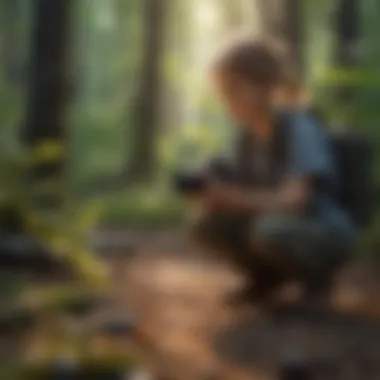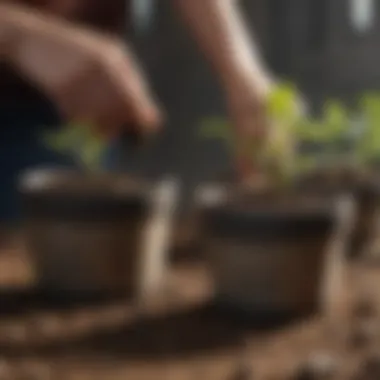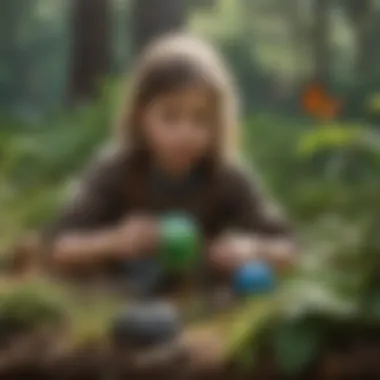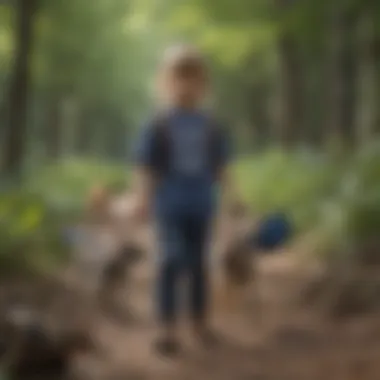Innovative Earth Day Activities for Young Minds


Nature Topic Overview
Earth Day is more than all eco-friendly activities. It is a global event that emphasizes the importance of protecting our planet and promoting a sustainable future. The theme focuses on the urgent need for greater environmental consciousness among the younger generations. Engaging children with innovative projects fosters their appreciation for nature and encourages responsibility toward it.
In this discussion, we explore creative ideas for Earth Day that make connections and inspire action. Whether at home or school, each idea encourages hands-on participation, focusing on fun ways to learn about and honor our environment.
Fun Facts and Trivia
To engage young readers, consider sharing fascinating facts:
- Over 1 billion people across the world celebrate Earth Day every year.
- The first Earth Day was celebrated in April 1970 in the United States.
- Planting a single tree can absorb up to 48 pounds of carbon dioxide a year.
Incorporate visuals and interactive elements like infographics and charts to make the learning exciting. This appeals not only to curiosity but to several learning styles that children may possess.
Wildlife Explorations
Different regions on earth are home to unique species of animals and plants awaiting discovery:
- Coral Reefs: Home to thousands of species, including clownfish and sea turtles.
- Rainforests: Include animals like jaguars and various species of orchids.
- Savannas: Known for elephants and African grasses.
Sharing facts about these creatures enhances knowledge, while quizzes or puzzles involving specifics about animals will help retain your audience’s interest. Ask: “What do manatees eat?” This encourages interaction and deeper thinking about wildlife.
Environmental Awareness
Understanding how to take care of nature emphasizes the importance of conservation. Children can contribute in simple ways:
- Reduce: Limit plastic use, starting with reusable bag for shopping.
- Reuse: Collect paper, plastic, or glass to create new projects and art.
- Recycle: Sort waste as a family or classroom activity that demonstrates teamwork.
- Plant trees up to five years create a perfect balance of oxygen.
Young readers should understand that every person can make a significant impact. Small actions add up to larger ones, leading to better outcomes for our planet.
DIY Nature Activities
Engaging kids through hands-on projects leads to deep-rooted learning:
- Create a Bird Feeder: Use natural items like pine cones coated with peanut butter and seeds. Children can observe and learn different bird varieties visiting.
- Nature Journals: Encourage logging environmental interactions—like trees seen or insects discovered. Summarize each new quote csitedaction.
- Outdoor Scavenger Hunt: List items to discover outdoors. For instance, find different leaves, rocks, or bugs!
- Step-by-Step:
- Collect the pine cone.
- Spread peanut butter over it.
- Roll in birdseed.
- Attach a string for hanging.
- Items included in the hunt might be:
- Red leaf
- Round pebble
- Butterfly's picture
Through these activities, children will actively connect with the natural world, thus strengthening a bond with sustainability.
Settlement: Encouraging curiosity while providing fun learning activities for kids fosters aware citizens who want to preserve this world. This Earth Day engagement is a stepping-stone for joyful exploration of the environment.
Understanding Earth Day
Understanding Earth Day is crucial for fostering a sense of ecological responsibility, especially among young audiences. This annual event underscores the value of nature and highlights our collective role in protecting the environment. Children aged 5 to 12 can benefit significantly from engaging with this topic. By understanding the background and relevance of Earth Day, they become empowered to take an active role in sustainability efforts.
History of Earth Day
The origin of Earth Day traces back to the grassroots movement in the United States during the late 1960s. The first Earth Day was celebrated on April 22, 1970, as a response to growing environmental issues such as pollution and habitat loss. This initiative was spearheaded by Senator Gaylord Nelson, who sought to raise awareness about environmental conservation. The event brought together millions of people to demonstrate for a healthy environment and has since transformed into a global occasion.
Earth Day has evolved significantly from its inception, marked not just by protest and awareness, but also by community engagement and educational activities. Today, there are many established Earth Day events, informational campaigns, and educational programs worldwide. Learning about its history allows kids to understand how environmental activism has deep-rooted origins, and how their engagement is part of a larger legacy of conservation efforts.
Importance of Earth Day
Earth Day serves multiple purposes. Primarily, it acts as a reminder of our duties towards the environment. Teaching children its importance can instill values of stewardship and conservation from a young age. Engaging with earth-friendly practices helps cultivate a sense of agency.
Understanding these principles enables children to connect their everyday actions with broader environmental issues. Discussions could revolve around topics like reducing waste, recycling, or conserving water. By addressing the why's and how's, active participation becomes more meaningful, facilitating a lifelong commitment to ecological sustainability.


In addition to personal responsibility, Earth Day highlights the relevance of multiplicity in voices when it comes to addressing climate concerns. Distributed engagement creates more robust discussions, leading to dynamic solutions for better environmental practices, serving as a practical blueprint for impactful action.
Global Participation in Earth Day
Earth Day has become a worldwide phenomenon, engaging individuals, communities, and institutions. Celebrations are now held in over 190 nations, offering an extensiveness shared global management for the environment. Children can see that they are part of a worldwide community addressing similar environmental challenges.
In schools and local organizations, for example, student-led initiatives— like clean-up campaigns— show that their actions contribute to a broader movement. This fact inspires them to see their role in the larger context of Earth Day affairs.
Moreover, participating in worldwide projects encourages exchanges of ideas and actions around sustainability. Children can witness how collective pursuits lead to meaningful change. This understanding can be motivating and reinforces the value of collaboration for better mental health and stronger community ties.
PROMOTING awareness and action among youths through these activities honors the spirit of Earth Day, ensuring that they become vigilant guardians of the planet.
Outdoor Activities for Kids
Engaging children in outdoor activities not only fosters a love for the environment but also enhances their physical and mental well-being. Nature is a natural classroom, rich with opportunities for learning and exploration. Outdoor activities encourage movement, creativity, and interpersonal skills as children interact with each other and their surroundings. Such activities can build eco-conscious attitudes by connecting youngsters to their local ecosystems, making the discussion of sustainability real and tangible. In this section, we will look at three detailed outdoor activities that can effectively engage kids in exploring nature.
Nature Scavenger Hunt
A nature scavenger hunt is an exciting and interactive way for children to explore the environment around them. Developing observational skills is at the heart of this activity. Children can search for various items like leaves, rocks, or flowers, turning their attention to the small details present in nature.
Tips for Organizing a Scavenger Hunt:
- Create a checklist of items commonly found in your area, depending on the season.
- Divide the children into small groups to promote teamwork.
- Provide maximum 30 minutes for the hunt to maintain energy levels and excitement.
This kind of activity harnesses curiosity and fosters an appreciation for biodiversity. Towards the end, discussing what each child found can lead to deeper conversations about local plants and animals, enhancing their connection to the surroundings.
Tree Planting Initiatives
Planting trees paints an impactful picture of restoring our planet's health. Tree planting initiatives uniquely combine physical activity with environmental responsibility. Children learn the significance of trees in combating climate change, sustaining wildlife, and cleaning air.
Steps to Conduct Tree Planting Sessions:
- Choose an Appropriate Location: Pick a public space, schoolyard, or community park needing tree planting.
- Select Native Species: Select species unique to your locale, ensuring they can thrive and support local wildlife.
- Educate Before Planting: Discuss the importance of the trees. Explain what they will accomplish and why planting trees is crucial.
As participants plant, they physically contribute to the earth's growth, creating a strong emotional bond with their actions. Each child leaves the session with a sense of belonging, as they play a role in enhancing their environment.
Community Clean-up Projects
Community clean-up projects are fantastic strategies to engage kids in environmental stewardship. Through these initiatives, children watch the immediate effects of their actions on their surroundings. Cleaning up parks, beaches, or neighborhood areas instills a sense of pride in their community's condition.
Guidelines for Leading Clean-up Efforts:
- Schedule a Day: Select a day when families can participate, raising community involvement.
- Provide Supplies: Ensure that gloves, trash bags, and recycling bins are available for the kids.
- Reflect: After the activity, organize a discussion regarding what has been collected and why waste management matters.
By participating in community clean-ups, kids learn the impacts of littering, fostering respect for their surroundings. The transcendental aspect of their contribution cannot be underestimated; kids recognize that protecting nature requires collective efforts, aligning their individual actions with broader sustainability goals.
Engaging kids in such outdoor activities builds a generation that values. Through play and exploration, they perceive earth-saving not as a chore but a joyful responsibility.
These activities not only fill Earth Day with meaning and enjoyment but also leave lasting impressions, shaping future advocates for the environment.
Creative Arts and Crafts
Engaging in creative arts and crafts for Earth Day is not only a celebration of our planet but also an opportunity to foster a sense of responsibility and awareness among young people. These activities offer diverse ways for children to connect with nature while enhancing their artistic skills. Craft projects using recycled materials can significantly reduce waste and instill valuable lessons about reusing and recycling. The choice of projects can stimulate critical thinking and ignite curiosity about ecological topics.
Recycled Art Projects
Recycled art projects are an effective way to transform discarded items into something beautiful and purposeful. This activity encourages kids to see the potential in everyday trash. Common household items like cardboard boxes, plastic bottles, and old newspapers can be utilized to create unique pieces of art. By turning what would otherwise be waste into art, children learn both creativity and sustainability.
Materials Needed:
- Cardboard boxes
- Plastic bottles
- Old magazines or newspapers
- Glue or tape
- Scissors
Kids can make sculptures, wall art, or even functional items like pencil holders. Incorporating discussion about where products come from and their impact on the environment further deepens their understanding. Techniques like collage-making from old magazines allow children to express themselves while also delivering clear teaching moments about reducing waste.
Nature-Inspired Crafts


Nature-inspired crafts directly draw from the environment, engaging kids with the beauty around them. These projects encourage young learners to appreciate the resources nature provides and create art that reflects their connection to the outdoors. Using leaves, flowers, and twigs can illuminate the significance of each element in our ecosystem.
Children can also explore methods such as leaf printing. By covering leaves in paint and pressing them onto paper, they can make stunning imprints that highlight the varying textures and shapes endemic to local foliage. Collecting items for crafts can serve as a fun excursion to nature, reinforcing eco-conscious behavior through exploration. Setting up these activities in a garden or park can amplify the sense of place while teaching children to respect and understand their surroundings.
DIY Bird Feeders
Creating DIY bird feeders is an engaging way to show respect for wildlife. This project gives children insight into the needs of local birds, promoting a sense of stewardship and curiosity about animal habitats. Not only do these feeders provide nourishment for birds, but they also encourage children to observe local wildlife.
Materials Needed:
- Pine cones
- Peanut butter (or a plant-based alternative)
- Birdseed
- String
To create a simple bird feeder, kids can spread peanut butter over a pine cone and roll it in birdseed, then hang it outside using the string. Watching birds flock to the feeder can be highly rewarding and is a practical lesson on the importance of biodiversity. This project also underscores the necessity of supporting local ecosystems throughout the year.
Incorporating arts and crafts to celebrate Earth Day speaks to creativity, awareness, and the nurturing of eco-friendly habits among children.
These hands-on projects illustrate important principles of sustainability and connect kids to the beauty of nature. In engaging them through creativity, we prepare the next generation to care for the environment more effectively. This approach empowers children to act intentionally and respectfully towards their surroundings.
By integrating creative arts and crafts into Earth Day activities, we enable meaningful learning experiences. These insights and skills can remain with children, influencing their choices long after the celebrations conclude.
Educational Workshops and Sessions
Educational workshops and sessions play a crucial role in fostering a deep understanding of environmental issues. Interactive sessions make complicated topics accessible and engaging for younger audiences. They focus on fostering curiosity and motivation toward nature. The importance of these programs lies not only in providing knowledge, but also in inspiring action and responsible behavior. Children, when informed, can become advocates for change within their communities.
You can structure educational workshops around timely topics that resonate with children's interests while providing beneficiaries something substantial.
Quote: "Education is the most powerful weapon which you can use to change the world." - Nelson Mandela
Guest Speakers on Environmental Issues
Inviting guest speakers to present their expertise on environmental issues is a powerful way to connect children with real-world applications. They can share personal stories, scientific insights, and encourage discussions about contemporary topics such as climate change, endangered species, and pollution.
Consider necessary planning aspects for these sessions. A brief introduction to the speaker beforehand can set the stage for the audience. Prepare age-appropriate questions to prompt dialogues between the students and the speaker. Following the interaction, hold a reflection activity where students can record what they learned, encouraging critical thinking.
Nature Conservation Workshops
Nature conservation workshops introduce children to essential themes around ecosystem preservation. Attendees can learn about local flora and fauna, habitats, and conservation challenges. It provides hands-on activities tailored to students, such as habitat restoration or species identification. These vigilant workshops develop a sense of stewardship and deeper respect for nature.
Focus on collaboration both among peers and with local outdoor education organizations. Use these opportunities to present real success stories about conservation efforts that resonated within the participants’ communities, making the information relatable.
Gardening and Sustainability Classes
Gardening and sustainability classes offer kids practical skills tied to environmental awareness. Children can learn how to start a garden, grow their own food, and understand sustainable practices, which helps foster a long-term connection to nature.
Key points to address during these classes could be:
- Basics of planting seeds and caring for plants.
- Importance of organic residues and sustainable composting.
- Tools and supplies necessary for gardening.
Develop exercises that encourage cooperative learning. For example, team presentations on the plants they are growing can lead to both educational and fun experiences.
Each of these workshop ideas builds valuable knowledge and skills focused on nature that promote personal growth and responsibility.
Digital Initiatives for Earth Day
In today's digital age, online engagement is a powerful tool for young learners. Using digital initiatives, kids can explore environmental education in ways that are innovative and engaging. These activities provide unique opportunities for broadening understanding and appreciation of nature, without requiring abandonment of the comforts that technology provides.
Crafting online events for Earth Day encourages children to unite and share their knowledge, making it a collaborative effort. These initiatives inspire young minds to take action regarding environmental issues. This can result in exciting experiences no matter where one is located. Additionally, digital platforms eliminate barriers, allowing for global participation.
Online Nature Quizzes
Online nature quizzes offer a fun and interactive format for young learners. Engaging with quizzes helps in reinforcing knowledge while making learning enjoyable. Children can test their understanding of flora and fauna, habitats, and environmental awareness. Platforms like Kahoot! or Quizizz provide features that allow both individual learning and group sessions, fostering a sense of connection even when participants are remote.
Benefits of digital quizzes include:
- Reinforcement of knowledge through play.
- Accessible anywhere, allowing participation from home or school.
- Encouraging collaborative competition among peers.
- Often contribution to overall digital literacy, important for today’s world.


Virtual Field Trips
Virtual field trips allow children to experience nature and conservation areas they might not access otherwise. Organizations like National Geographic or The Nature Conservancy offer tours that immerse children in specific habitats or ecosystems. These guided online experiences can easily bring concepts discussed in class to life.
Considerations include:
- Selecting age-appropriate content.
- Engaging with experts who can answer kids' questions.
- Creating a follow-up discussion for students to share their favorite moments or discoveries after the trip. (This may also integrate with classroom learning).
Benefits of virtual trips:
- Broadens horizons without geographical limitations.
- Provides a chance to witness rare environments or animals.
- Engages children in real-world conservation efforts.
Eco-Friendly Video Content
Video content aimed at educating young viewers about the environment can have a significant impact. There are numerous resources available on platforms such as YouTube, with channels like SciShow Kids or Cosmic Kids Yoga providing fun and informative insights about nature and sustainability.
This kind of content promotes a greater understanding of conservation, often delivered in engaging, child-friendly formats. Parents and teachers can evaluate videos based on educational value, clearly explained concepts, and the use of factual information.
Factors to consider include:
- Embedding these videos into lesson plans.
- Hosting discussions on content interpretation.
- Encouraging kids to create their own video projects to echo the themes explored in these resources.
Consider leveraging materials that reflect positive ecological practices.
Instead of merely informing, inspired video content empowers children to participate in environmental protection actively by sharing what they learn with others.
Investing in these digital initiatives ensures a comprehensive approach. This guarantees that children develop a deep and lasting appreciation for their planet.
Fostering Long-Term Environmental Mindset
Fostering a long-term environmental mindset in children receives limited attention in traditional educational frameworks. This shift is necessary, however, as it promotes sustainability in behavior and thinking. Helping children understand their impact on the environment is crucial. Each action they take, from recycling to conserving water, contributes to a larger goal of ecological preservation.
Developing Eco-Friendly Habits
Creating eco-friendly habits involves more than just one-time activities. Regular practice introduces eco-conscious routines into daily life. Parents and teachers can help children learn simple actions that contribute to a sustainable lifestyle. This includes:
- Recycling materials properly.
- Turning off lights when exiting a room.
- Using reusable bags for shopping.
- Conserving water while brushing teeth.
Consistent reminders and engaging activities can reinforce these behaviors. Habits develop through time and repetition. When these routines become ingrained in everyday life, they positively shape children's perceptions of nature.
Motivating Kids to Advocate for Nature
Motivating children to advocate for nature engages them at an emotional level. It's important to show them how their voices matter. Encouraging children to take part in activities like writing letters to local officials about environmental issues fosters a sense of agency. Mixed media presents another outlet. For example, creating art projects from found objects serves a dual purpose: creative expression and environmental engagement. On a larger scale, participation in schools or community groups holds significant value. Through teamwork, kids feel a sense of togetherness focused on protecting their surroundings.
Resources for Continued Learning
Lastly, continuous education about the environment helps sustain student eagerness. Numerous resources are available:
- Books suitable for children aged 5-12 that highlight environmental themes.
- Online platforms like environmental blogs or Wikipedia pages dedicated to ecological topics.
- Local workshops that emphasize sustainability focused on children’s learning.
By utilizing these mediums, information about nature becomes accessible and engaging. Educators and parents can build upon this knowledge, effectively equipping children's minds for future environmental challenges.
Engaging with the environment through ongoing learning ensures that children remain connected to nature throughout their lives.
Closure: Celebrating Earth Day Every Day
Recognizing Earth Day is about more than just a single day each year. It is vital to embrace the idea that every day can reflect our commitment to the planet. This article has explored various creative ideas for engaging young audiences in Earth Day activities. The extended concepts invite continual interactions with nature, fostering a deep-rooted environmental mindset.
Developing eco-friendly habits early in life can create a generation that genuinely values sustainability. The involvement of children in various activities encourages them to advocate for nature in their daily routines. Parents and educators should use these ideas as starting points for conversations on environmental issues.
Over time, these small actions can lead to larger commitments toward sustainability. For instance, kids learning to recycle or conserve water can realize the impact of their behaviors on the environment. Furthermore, integrating these practices into long-term routines supports ongoing environmental consciousness.
Encouraging continual Earth Day observance promotes a profound understanding of our relationship with nature.
With a focus on learning and exploration, encouraging activities outside of Earth Day can ensure that environmental education is consistent. Ongoing dialogues in schools and homes about ecological topics can lead to a nuanced appreciation of nature’s complexities.
Key Considerations:
- Consistency: Make sustainability part of daily life, not just an occasion.
- Education: Use responsive and creative resources for continual learning on environmental topics.
- Participation: Encourage community involvement, reinforcing collective action toward ecological sustainability.
In summary, celebrating Earth Day every day shifts the focus from a one-time event to an enduring practice. The effectiveness of engaging children in environmental activities builds their confidence to speak fiercely about preservation issues. A generation aware of its behaviors and their consequences on Earth will embrace and advance sustainable practices into the future. Each seed planted today will yield a forest of knowledge for tomorrow.







